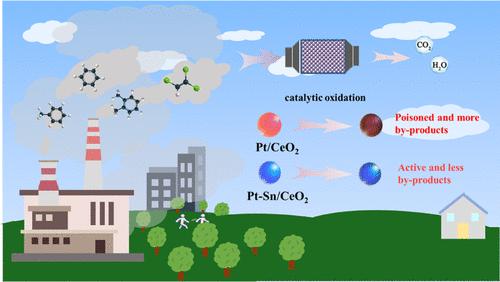当前位置:
X-MOL 学术
›
Environ. Sci. Technol.
›
论文详情
Our official English website, www.x-mol.net, welcomes your
feedback! (Note: you will need to create a separate account there.)
Engineering Platinum Catalysts via a Site-Isolation Strategy with Enhanced Chlorine Resistance for the Elimination of Multicomponent VOCs
Environmental Science & Technology ( IF 10.8 ) Pub Date : 2022-06-21 , DOI: 10.1021/acs.est.2c00437 Ruyi Gao 1 , Manchen Zhang 2 , Yuxi Liu 1 , Shaohua Xie 3 , Jiguang Deng 1 , Xiaoxing Ke 3 , Lin Jing 1 , Zhiquan Hou 1 , Xing Zhang 3 , Fudong Liu 3 , Hongxing Dai 1
Environmental Science & Technology ( IF 10.8 ) Pub Date : 2022-06-21 , DOI: 10.1021/acs.est.2c00437 Ruyi Gao 1 , Manchen Zhang 2 , Yuxi Liu 1 , Shaohua Xie 3 , Jiguang Deng 1 , Xiaoxing Ke 3 , Lin Jing 1 , Zhiquan Hou 1 , Xing Zhang 3 , Fudong Liu 3 , Hongxing Dai 1
Affiliation

|
Pt-based catalysts can be poisoned by the chlorine formed during the oxidation of multicomponent volatile organic compounds (VOCs) containing chlorinated VOCs. Improving the low-temperature chlorine resistance of catalysts is important for industrial applications, although it is yet challenging. We hereby demonstrate the essential catalytic roles of a bifunctional catalyst with an atomic-scale metal/oxide interface constructed by an intermetallic compound nanocrystal. Introducing trichloroethylene (TCE) exhibits a less negative effect on the catalytic activity of the bimetallic catalyst for o-xylene oxidation, and the partial deactivation caused by TCE addition is reversible, suggesting that the bimetallic, HCl-etched Pt3Sn(E)/CeO2 catalyst possesses much stronger chlorine resistance than the conventional Pt/CeO2 catalyst. On the site-isolated Pt–Sn catalyst, the presence of aromatic hydrocarbon significantly inhibits the adsorption strength of TCE, resulting in excellent catalytic stability in the oxidation of the VOC mixture. Furthermore, the large amount of surface-adsorbed oxygen species generated on the electronegative Pt is highly effective for low-temperature C–Cl bond dissociation. The adjacent promoter (Sn–O) possesses the functionality of acid sites to provide sufficient protons for HCl formation over the bifunctional catalyst, which is considered critical to maintaining the reactivity of Pt by removing Cl and decreasing the polychlorinated byproducts.
中文翻译:

通过增强耐氯性的场地隔离策略设计铂催化剂以消除多组分 VOC
Pt 基催化剂可能会因在含有氯化 VOC 的多组分挥发性有机化合物 (VOC) 的氧化过程中形成的氯而中毒。提高催化剂的低温耐氯性对于工业应用很重要,尽管它仍然具有挑战性。我们在此证明了具有由金属间化合物纳米晶体构成的原子级金属/氧化物界面的双功能催化剂的基本催化作用。引入三氯乙烯 (TCE) 对邻二甲苯氧化双金属催化剂的催化活性的负面影响较小,并且由 TCE 添加引起的部分失活是可逆的,这表明双金属、HCl 蚀刻的 Pt 3 Sn(E)/氧化铈2催化剂比传统的Pt/CeO 2催化剂具有更强的耐氯性。在位点隔离的 Pt-Sn 催化剂上,芳烃的存在显着抑制了 TCE 的吸附强度,从而在 VOC 混合物的氧化中具有优异的催化稳定性。此外,在电负性 Pt 上产生的大量表面吸附氧对低温 C-Cl 键解离非常有效。相邻的促进剂 (Sn-O) 具有酸性位点的功能,可以为双功能催化剂上的 HCl 形成提供足够的质子,这对于通过去除 Cl 和减少多氯代副产物来保持 Pt 的反应性至关重要。
更新日期:2022-06-21
中文翻译:

通过增强耐氯性的场地隔离策略设计铂催化剂以消除多组分 VOC
Pt 基催化剂可能会因在含有氯化 VOC 的多组分挥发性有机化合物 (VOC) 的氧化过程中形成的氯而中毒。提高催化剂的低温耐氯性对于工业应用很重要,尽管它仍然具有挑战性。我们在此证明了具有由金属间化合物纳米晶体构成的原子级金属/氧化物界面的双功能催化剂的基本催化作用。引入三氯乙烯 (TCE) 对邻二甲苯氧化双金属催化剂的催化活性的负面影响较小,并且由 TCE 添加引起的部分失活是可逆的,这表明双金属、HCl 蚀刻的 Pt 3 Sn(E)/氧化铈2催化剂比传统的Pt/CeO 2催化剂具有更强的耐氯性。在位点隔离的 Pt-Sn 催化剂上,芳烃的存在显着抑制了 TCE 的吸附强度,从而在 VOC 混合物的氧化中具有优异的催化稳定性。此外,在电负性 Pt 上产生的大量表面吸附氧对低温 C-Cl 键解离非常有效。相邻的促进剂 (Sn-O) 具有酸性位点的功能,可以为双功能催化剂上的 HCl 形成提供足够的质子,这对于通过去除 Cl 和减少多氯代副产物来保持 Pt 的反应性至关重要。











































 京公网安备 11010802027423号
京公网安备 11010802027423号